“Pittsbourgh” was named in honor of William Pitt, the 1st Earl of Chatham. He was a well-known and much respected British statesman. The letter informing him that he was the eponymous person of a new settlement in the Pennsylvania Colony spelled the name, Pittsbourg, without its final “h.”
In 1816, when the city charter was written, the town officials changed the name to “Pittsburgh” and so it was for years. Then at a time that cannot be agreed upon, a printing error on city documents omitted the final “h.”
The question was, “Do we need the “h” or not?” There were serious discussions that said, yes, and some that said, “no.” There were frivolous discussions. The were jokes. There was debate from all sides: elected officials, newspaper editors, industrial tycoons, clergymen, educators, and even postmasters.

Then the United States Board on Geographic Names (BGN) was asked to reach a decision on how Pittsburg should spell its name. On July 19, 1911, the “h” was restored.
Yes, America, there really is a Board on Geographic Names. It is a federal body created in 1890 during the Harrison Administration. It functions in its present form by Public Law of 1947 to maintain uniform geographic name usage throughout the Federal Government.
**
Pittsburgh is the second largest city in Pennsylvania. In 2020, census bureau workers enumerated just under 303,000 residents. The population of the city has fluctuated widely over the decades. In 1950 there were nearly double the number of residents as there are today. When these postcards were manufactured (c. 1906) it could be estimated that the population was just over 425,000.
Manufacturing in the city and surrounding suburbs include glass, steel, paint, aluminum (Alcoa), electronics (Westinghouse), and food processing (currently Kraft and Heinz). All these businesses came to western Pennsylvania because the area developed as a natural gateway to the west. Rivers and railroads were parts of that equation.
Serious community development started in the last half of the nineteenth century and continued well into the 1940s. Pittsburgh reached its population peak in the 1950s.
**
Raphael Tuck & Sons entered the American postcard market in 1900. Their successful operation in England had served most of Europe and parts of Asia, for more than three decades. It isn’t hard to imagine that a similar operation was planned for North America, but nobody would have predicted that in just 15 years the world would be at war. The war became a business factor of extremes. Tuck’s North American adventure soon became quite provincial.
The American view cards manufactured by the new Tuck operation in New York first appeared around 1904 with a very limited list of locations. At least a dozen American cities were added to the catalog within three years. The Pittsburgh views first appeared early in 1906. The cards have undivided back that follow the identical postcard apparatus used in Europe. The words “Printed in Holland” are difficult to find on most of the cards, but the phrase is found on the front within the picture. The series was made in three print processes: in RAPHOTYPE, numbered 5000-5023; same image, title & description in COLLOTYPE number 6000-6023), and in SILVERETTE, number 7000-7023. This checklist features only the RAPHOTYPE series.
Samples of the Tuck series
PITTSBURGH with ALLEGHENY, HOMESTEAD & RANKIN
Pittsburgh, Pennsylvania, is well-known for its unique geography, defined by the convergence of three major rivers: the Allegheny, the Monongahela, and the Ohio. These rivers have played a pivotal role in shaping the city’s history, economy, and culture.

The river history begins at The Point. The Monongahela flows from the East, the Allegheny from the north and they join Ohio to continue west to the Mississippi.
Where there are rivers, there are bridges, too! Pittsburgh has 446 bridges, making it the city with the most bridges in the world.


Highland Park is a quiet residential area. A portion of the neighborhood is the vast park of the same name. There are hiking trails, a lake, picnic areas and the Victorian-style Entry Garden. The park is also home to a zoo and an aquarium.

One of the most famous names in the area is Andrew Carnegie. The library in Pittsburgh has been a center of learning since the 1890s when Pittsburgh became the home of eight Carnegie libraries. In total, 2,509 libraries were constructed across the U. S. over a period of 46 years with funds donated by the Scottish-American businessman.
Where there are rivers, there are railroads. Pittsburgh has three stations.
and the Canon Ball trains stopped (at least between 1950 and 1971) at
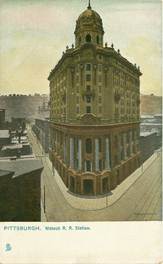
.
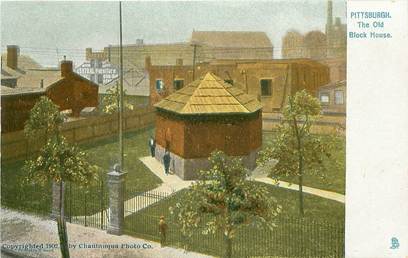
Pittsburgh has but one ancient structure from its Pre-Revolutionary days, it’s the Old Fort Pitt Block House, built in 1764 as a defensive military redoubt. A small number of similar structures around the outer walls of the fort were meant to reinforce its defenses. The “old” one is the only Fort Pitt Block House that survives.
Today there are more than 2,200 religious organizations and churches in the greater Pittsburgh metropolitan area, however in 1906, when these cards were new Saint Paul’s Cathedral was the newest, the most polished, and the most revered.
The “Old” Post Office Building, or Fourth Avenue Post Office, was located at Fourth Avenue and Smithfield Street in downtown Pittsburgh. It was originally constructed in the 1880s. The building was plagued with problems but served the citizens until 1934. The 75-year-old building was demolished in 1966. It was replaced by an urban park.
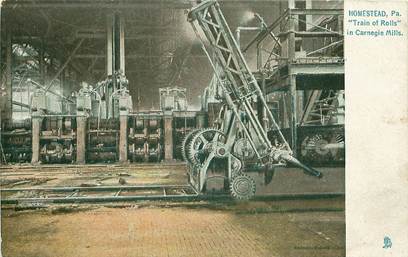
One of Andrew Carnegie’s mills located in Homestead, Pennsylvania, is shown
on this card. The caption reads, “Train of Rolls.” The phrase is part of the
steel industry’s lexicon. A train of rolls in the steel industry is a series of rollers that work together to shape and flatten steel. The rollers are used in a process called roll forming, which is a continuous bending operation.
One prominent Pittsburgh suburb is Allegheny.
Two distinctive destinations in Allegheny are the post office, built in 1897 and the city park. The Allegheny is one of the oldest purpose built parks in the country, established as a grazing area in 1784, and redesigned in 1867 by pioneer landscape architects Mitchell and Grant. It was the first public space in America to have a carriage drive and Civil War monuments.



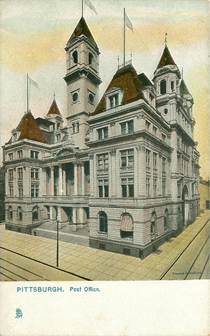

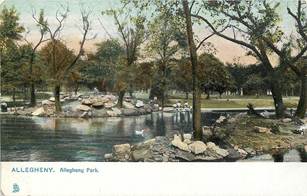
Loved this article. Keep them coming Mr Palmer.
Looking forward to the upcoming articles in this series, Graham!
Enjoyed reading the article. Loved the postcards. Looking forward to more American View postcards by Tuck.